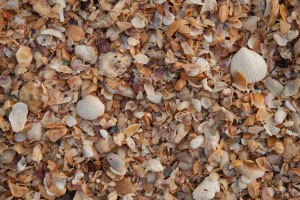 As we approached the island, I had that sinking feeling when you know reality is not going to meet expectations. At first glance, it was clear that our “resort” was a little more rustic than I had anticipated. My spirits raised a little when a young German girl welcomed us to our bungalow with a couple of cool, refreshing glasses of lemonade, but were then utterly dashed when she asked, “Would you like a rat trap for your bungalow – no extra charge.” And so began our stay on Koh Thomei, a small island flanked by mangrove forests part of Ream National Park. The island is uninhabited except for a few people and one resort. The Park is supposedly home to some of Cambodia’s most exquisite beaches. It was based on such descriptions that we thought we were heading to paradise.
As we approached the island, I had that sinking feeling when you know reality is not going to meet expectations. At first glance, it was clear that our “resort” was a little more rustic than I had anticipated. My spirits raised a little when a young German girl welcomed us to our bungalow with a couple of cool, refreshing glasses of lemonade, but were then utterly dashed when she asked, “Would you like a rat trap for your bungalow – no extra charge.” And so began our stay on Koh Thomei, a small island flanked by mangrove forests part of Ream National Park. The island is uninhabited except for a few people and one resort. The Park is supposedly home to some of Cambodia’s most exquisite beaches. It was based on such descriptions that we thought we were heading to paradise.
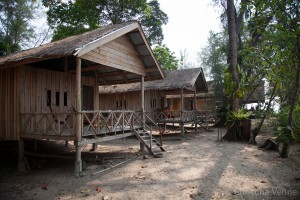 The resort is comprised of about 10 simple bungalows, modestly furnished with beds and rustic wardrobes, and equipped with modern ensuite bathrooms. The beds are enclosed in mosquito nets, an essential as the mosquitoes are rather fierce at night. We had an old fan in our room that didn’t do much, not that it mattered since power was turned off at 10:00 pm, just when you really needed the fan. The restaurant where we ate all our meals was an open air building also facing the sea. The food was delicious, prepared by one of the owners and her competent local staff. The bungalows were a bargain at $20 per night, and on average we spent about $60 day which covered all our food and drinks, including alcoholic beverages.
The resort is comprised of about 10 simple bungalows, modestly furnished with beds and rustic wardrobes, and equipped with modern ensuite bathrooms. The beds are enclosed in mosquito nets, an essential as the mosquitoes are rather fierce at night. We had an old fan in our room that didn’t do much, not that it mattered since power was turned off at 10:00 pm, just when you really needed the fan. The restaurant where we ate all our meals was an open air building also facing the sea. The food was delicious, prepared by one of the owners and her competent local staff. The bungalows were a bargain at $20 per night, and on average we spent about $60 day which covered all our food and drinks, including alcoholic beverages.
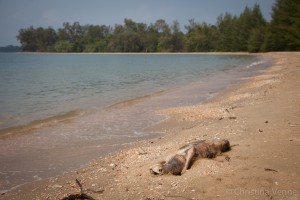 In spite of the offer of a rat trap, we never did see a rat while we were there. We did, however, see (and smell) a dead dog that had washed up on the shore (yuck!). As if that was not disturbing enough, that “pristine beach” we read about, sure didn’t exist on this part of the island. The resort owners were diligent about cleaning the beach around their property each day, but as soon as we ventured beyond, it felt like we were walking through a garbage dump. All manner of debris was washed up on shore.
In spite of the offer of a rat trap, we never did see a rat while we were there. We did, however, see (and smell) a dead dog that had washed up on the shore (yuck!). As if that was not disturbing enough, that “pristine beach” we read about, sure didn’t exist on this part of the island. The resort owners were diligent about cleaning the beach around their property each day, but as soon as we ventured beyond, it felt like we were walking through a garbage dump. All manner of debris was washed up on shore.
Perhaps you can understand my reluctance to go swimming in the water that was the source of such filth, not even dipping my toe in during the length of our stay. After just one walk on the beach, I decided to stay on the resort property, content to escape in my new book, “The Thousand Autumns of Jacob de Zoet” by David Mitchell, the same author who wrote “Cloud Atlas”. It was a great read (thanks Marc for the recommendation!) and I quite enjoyed lazing around each day.
The nights were an entirely different matter. The air was still, not a whiff of a breeze, and the mosquito net felt claustrophobic around us. We tossed and turned each night, sweating like pigs in the oppressive heat. After three nights, we were ready to move on – Can Tho, Vietnam was our next destination.
On our departure day, a couple of German girls who were in Cambodia working on assignment with Elle magazine, recommended we stop for lunch at Kimly’s, in a small seaside town called Kep, famous for their fried blue crab and world famous Kampot pepper. The girls were quick to explain that they had completed their assignment and were now on their own time (and dime) – after living rather extravagantly on the Elle travel budget. We already had plans to take the bus directly to the border, so we didn’t think a visit to Kep was in the cards for us.
 Lucky for us, our travel plans got all messed up that day. The boat was late, causing us to miss our bus. The only other transportation option was to take a taxi, an outrageous $50 fare to Kep. The resort owner offered $20 to cover the cost of our bus tickets (which we hadn’t yet purchased) which we accepted as fair compensation for what was their scheduling error and it helped take the bite out of our taxi fare. On the way to Kep, we decided to stay there overnight since there were no more buses to Vietnam at that time of day.
Lucky for us, our travel plans got all messed up that day. The boat was late, causing us to miss our bus. The only other transportation option was to take a taxi, an outrageous $50 fare to Kep. The resort owner offered $20 to cover the cost of our bus tickets (which we hadn’t yet purchased) which we accepted as fair compensation for what was their scheduling error and it helped take the bite out of our taxi fare. On the way to Kep, we decided to stay there overnight since there were no more buses to Vietnam at that time of day.
 Using our 3-year old Lonely Planet guide, we found a place to stay that sounded reasonable enough. It was in the budget section and was described as a modest group of bungalows in a garden setting. It would be fine for one night. Little did we know that we picked one of the nicest resorts in the area. Vanna Bungalow Resort had undergone a major facelift since our guide book was written and was now more upscale, complete with a gorgeous pool overlooking the sea. The resort is set high on the hillside and offers sweeping views of the coastline and sea. It was nothing short of spectacular, and at $35 per night including a delicious breakfast, it was good value too.
Using our 3-year old Lonely Planet guide, we found a place to stay that sounded reasonable enough. It was in the budget section and was described as a modest group of bungalows in a garden setting. It would be fine for one night. Little did we know that we picked one of the nicest resorts in the area. Vanna Bungalow Resort had undergone a major facelift since our guide book was written and was now more upscale, complete with a gorgeous pool overlooking the sea. The resort is set high on the hillside and offers sweeping views of the coastline and sea. It was nothing short of spectacular, and at $35 per night including a delicious breakfast, it was good value too.
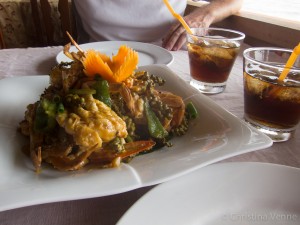 Our one night turned into three during which time we feasted at Kimly’s on their infamous fried blue crab and green Kampot peppers, and toured the countryside with a very knowledgeable tuk tuk driver, Mr. Dy. We discovered the area was rich in beauty and resources – the sea served up all manner of seafood – squid, eel, crab, fish. We visited salt flats, fruit orchards, and a pepper plantation. We saw large concrete swallow houses where the nests are sold to the Chinese for the swallow spit, a lucrative business fetching $2,000-$3,000 per kilogram. The saliva is a main ingredient in bird’s nest soup, a Chinese delicacy supposedly rich in nutrients, and traditionally believed to offer health benefits such as aiding digestion, raising libido, improving the voice, alleviating asthma, improving focus and an overall benefit to the immune system.
Our one night turned into three during which time we feasted at Kimly’s on their infamous fried blue crab and green Kampot peppers, and toured the countryside with a very knowledgeable tuk tuk driver, Mr. Dy. We discovered the area was rich in beauty and resources – the sea served up all manner of seafood – squid, eel, crab, fish. We visited salt flats, fruit orchards, and a pepper plantation. We saw large concrete swallow houses where the nests are sold to the Chinese for the swallow spit, a lucrative business fetching $2,000-$3,000 per kilogram. The saliva is a main ingredient in bird’s nest soup, a Chinese delicacy supposedly rich in nutrients, and traditionally believed to offer health benefits such as aiding digestion, raising libido, improving the voice, alleviating asthma, improving focus and an overall benefit to the immune system.
The salt flats reminded us of our tour of the salt flats in Bolivia.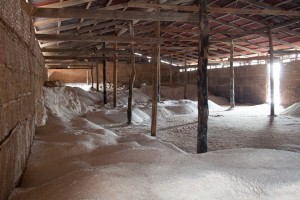
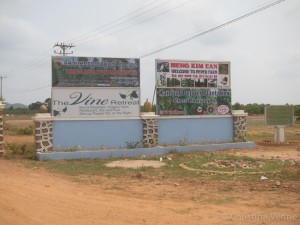 Pepper plantation where green (fresh), red, black and white pepper
Pepper plantation where green (fresh), red, black and white pepper
is harvested from the same plants. Kampot Pepper is world
renowned (although we had never heard of it before).
 Jack Fruit, similar to Durian Fruit but less smelly. Just one
Jack Fruit, similar to Durian Fruit but less smelly. Just one
of the many fruit trees we saw at the pepper plantation.
 Sparrow houses where sparrow spit is collected for bird’s nest soup.
Sparrow houses where sparrow spit is collected for bird’s nest soup.
Kep National Park was literally just behind our resort and the trail head to a pleasant 8 km loop around the mountain was a five minute walk away. Half of the trail was well shaded, passing through lush jungle and tropical rain forest where we saw bright, colourful butterflies and many varieties of exotic birds. The other half of the trail was less impressive, following a dirt road back to the beginning with no shade whatsoever. The trail is maintained by a local cafe, Led Zep, who have installed excellent signs along the trail and lots of benches at the scenic vistas.
Somewhat reluctantly, after three days, we packed our bags and headed for Can Tho, Vietnam, a mere 200 km away. Little did we know it would take 10 hours to get there, but I’ll save that story for another time.

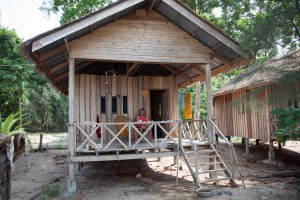
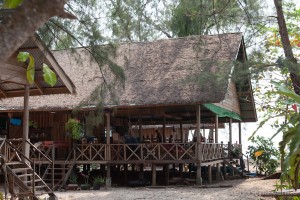

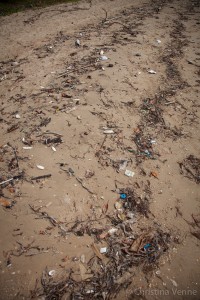
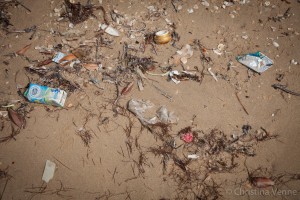
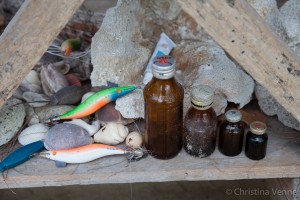
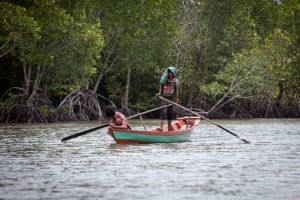
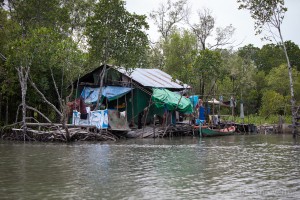
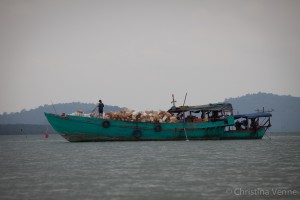



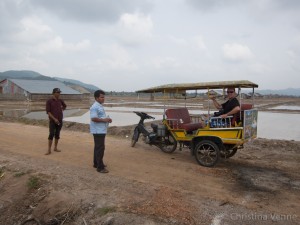


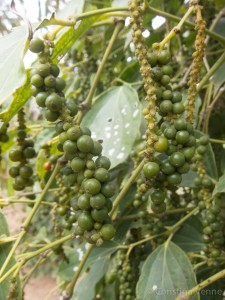
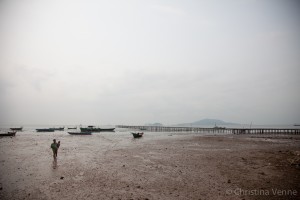
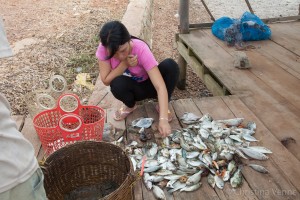
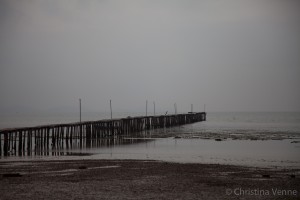


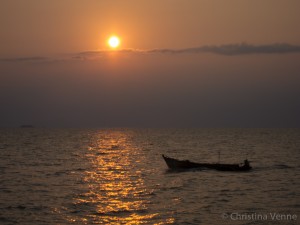
Hey Guys….enjoy your posts. We know Mike and Dianne Dupont and hung out with them in Costa Rica this month…they kept talking about you guys! All good of course…enjoy! Robert Provencher
Hi Rob! Thanks for tuning in! Costa Rica… we haven’t made it there YET… gotta save some places for the next time! Sounds like a great place to be for say, January to April! Say hi to the Dupont’s for me!
Chris